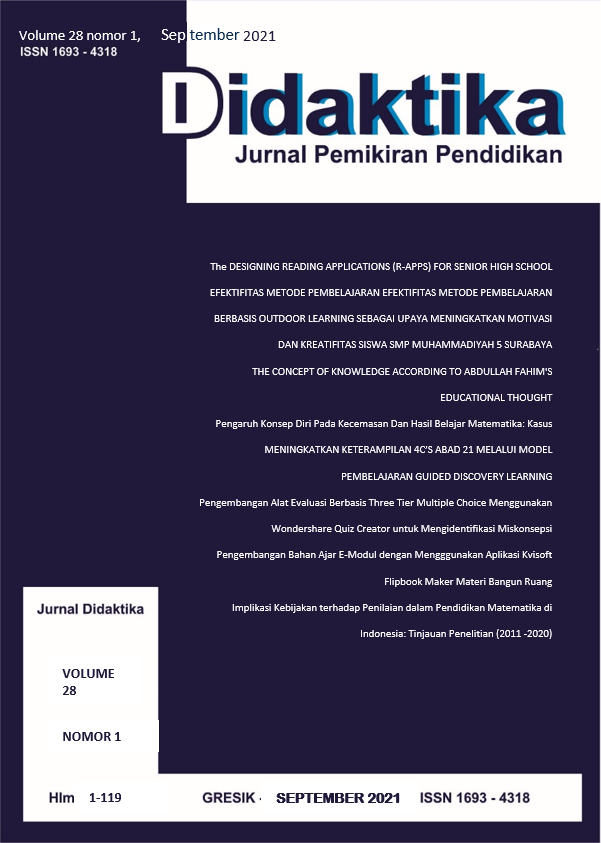Pengembangan Alat Evaluasi Berbasis Three Tier Multiple Choice Menggunakan Wondershare Quiz Creator untuk Mengidentifikasi Miskonsepsi
DOI:
https://doi.org/10.30587/didaktika.v28i1.3902Keywords:
Development Research (R&D), evaluation tool, three tier multiple choice, wondershare quiz creator, misconception.Abstract
Evaluation can be used to measure the understanding of students' concepts in geometry material. However, there are still many students who have difficulty in understanding the concept of geometry. This often leads to misconceptions. An effort to identify misconceptions is to conduct a three-tier multiple choice-based evaluation test. Evaluation can take advantage of online question maker technology such as the Wondershare Quiz Creator application. The purpose of this research is to develop a three tier multiple choice based evaluation tool using wondershare quiz creator to identify misconceptions that can be used online. The development research model uses the 4D model. The research subjects were students of class VII-A SMPN 5 Lamongan. The research instruments used were interview sheets, validation sheets, test instruments, and questionnaires. The data analysis technique used qualitative and quantitative analysis. The result of the research is an evaluation tool based on three tier multiple choice using wondershare quiz creator to identify misconceptions as seen from: (1) the appropriateness of the evaluation tool meets the valid and effective criteria which reaches more than 60%. As well as with the statistical tests carried out, the instrument has met the criteria given so that the evaluation tool can be used. (2) Types of misconceptions consist of classification misconceptions, correlational misconceptions, and theoretical misconceptions. Of the three types of misconceptions, students experienced the most misconceptions at level 2, namely answering incorrect choice of reasons.
Downloads
Published
How to Cite
Issue
Section
License
License and Copyright Agreement
In submitting the manuscript to the journal, the authors certify that:
- They are authorized by their co-authors to enter into these arrangements.
- The work described has not been formally published before, except in the form of an abstract or as part of a published lecture, review, thesis, or overlay journal.
- That it is not under consideration for publication elsewhere,
- That its publication has been approved by all the author(s) and by the responsible authorities – tacitly or explicitly – of the institutes where the work has been carried out.
- They secure the right to reproduce any material that has already been published or copyrighted elsewhere.
- They agree to the following license and copyright agreement.
Copyright
Authors who publish with DIDAKTIKA: Jurnal Pemikiran Pendidikan agree to the following terms:
- Authors retain copyright and grant the journal right of first publication with the work simultaneously licensed under a Creative Commons Attribution License (CC BY-SA 4.0) that allows others to share the work with an acknowledgment of the work's authorship and initial publication in this journal.
- Authors are able to enter into separate, additional contractual arrangements for the non-exclusive distribution of the journal's published version of the work (e.g., post it to an institutional repository or publish it in a book), with an acknowledgment of its initial publication in this journal.
- Authors are permitted and encouraged to post their work online (e.g., in institutional repositories or on their website) prior to and during the submission process, as it can lead to productive exchanges, as well as earlier and greater citation of published work.
Licensing for Data Publication
Open Data and Software Publishing and Sharing
The journal strives to maximize the replicability of the research published in it. Authors are thus required to share all data, code or protocols underlying the research reported in their articles. Exceptions are permitted but have to be justified in a written public statement accompanying the article.
Datasets and software should be deposited and permanently archived inappropriate, trusted, general, or domain-specific repositories (please consult http://service.re3data.org and/or software repositories such as GitHub, GitLab, Bioinformatics.org, or equivalent). The associated persistent identifiers (e.g. DOI, or others) of the dataset(s) must be included in the data or software resources section of the article. Reference(s) to datasets and software should also be included in the reference list of the article with DOIs (where available). Where no domain-specific data repository exists, authors should deposit their datasets in a general repository such as ZENODO, Dryad, Dataverse, or others.
Small data may also be published as data files or packages supplementary to a research article, however, the authors should prefer in all cases a deposition in data repositories.











